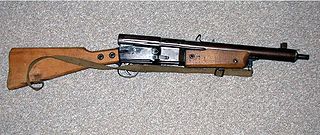 W
WThe Fusil Automatique Modèle 1917, also called the RSC M1917, was a gas-operated, semi-automatic rifle placed into service by the French Army during the latter part of World War I. It was chambered in 8mm Lebel, the rimmed cartridge used in other French Army infantry weapons of the time. In total, the French national armories, primarily Manufacture d'armes de Saint-Étienne (MAS) and Manufacture Nationale d'Armes de Tulle (MAT), manufactured 86,000 RSC M1917 rifles until production ended in late November 1918. However, very few examples have survived in fully-functional, semi-automatic condition and those have become highly sought-after collectibles.
 W
WThe Gewehr 41, commonly known as the G41(W) or G41(M), denoting the manufacturer, is a battle rifle manufactured and used by Nazi Germany during World War II. It was largely superseded by the Gewehr 43, which incorporated a more reliable method of operation.
 W
WThe Gewehr 43 or Karabiner 43 is a 7.92×57mm Mauser caliber semi-automatic rifle developed by Germany during World War II. The design was based on that of the earlier G41(W), but incorporated an improved short-stroke piston gas system similar to that of the Soviet Tokarev SVT-40. It was manufactured using innovative mass-production techniques.
 W
WThe M1 carbine is a lightweight semi-automatic carbine that was a standard firearm for the U.S. military during World War II, the Korean War and the Vietnam War. The M1 carbine was produced in several variants and was widely used by paramilitary and police forces around the world, and also became a popular civilian firearm after World War II.
 W
WThe M1 Garand or M1 Rifle is a .30-06 caliber semi-automatic battle rifle that was the standard U.S. service rifle during World War II and the Korean War and also saw limited service during the Vietnam War. Most M1 rifles were issued to U.S. forces, though many hundreds of thousands were also provided as foreign aid to American allies. The Garand is still used by drill teams and military honor guards. It is also widely used by civilians for hunting, target shooting, and as a military collectible.
 W
WThe SKS is a semi-automatic carbine chambered for the 7.62×39mm round, designed in 1943 by Sergei Gavrilovich Simonov. A reliable, simply designed, and relatively inexpensive weapon, the SKS was first produced in the Soviet Union but later widely exported and manufactured by various nations. Its distinguishing characteristics include a permanently attached folding bayonet and a hinged, fixed magazine. As the SKS lacked select-fire capability and its magazine was limited to ten rounds, it was rendered obsolete in the Soviet Armed Forces by the introduction of the AK-47 in the 1950s. Nevertheless, SKS carbines continued to see service with the Soviet Border Troops, Internal Troops, and second-line and reserve army units for decades.
 W
WThe SVT-40 is a Soviet semi-automatic battle rifle. The SVT-40 saw widespread service during and after World War II. It was intended to be the Soviet Red Army's new service rifle, but its production was disrupted by the German invasion in 1941, resulting in a change back to the Mosin–Nagant rifle for the duration of World War II. After the war, the Soviet Union adopted new rifles, such as the SKS and the AK-47.
 W
WThe Volkssturmgewehr is the name of several rifle designs developed by Nazi Germany during the last months of World War II. They share the common characteristic of being greatly simplified as an attempt to cope with severe lack of resources and industrial capacity in Germany during the final period of the war.